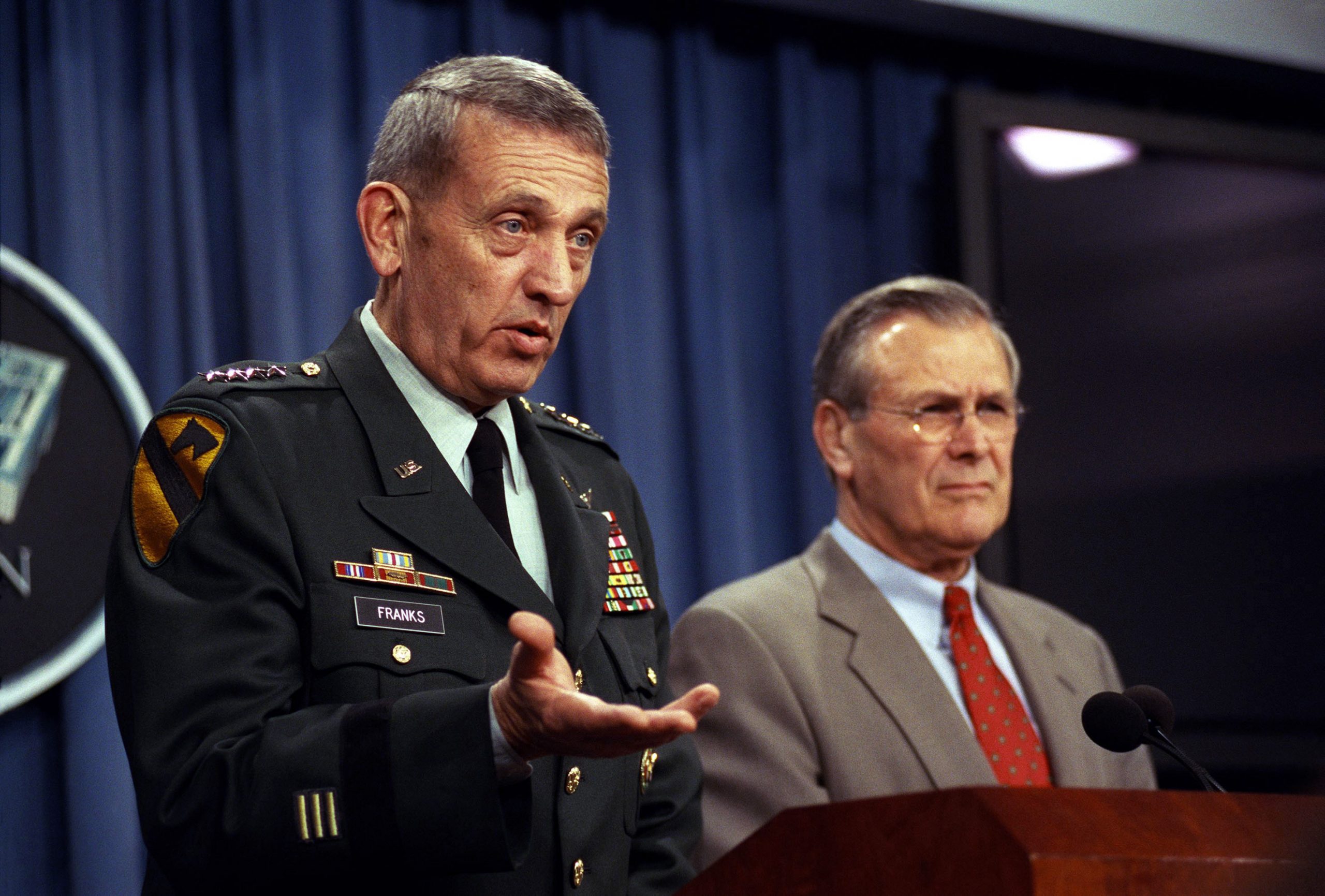
MAP BREAK
Soldiers at the Tactical Systems Integration Facility at Aberdeen Proving Ground, Maryland, use digital planning platforms to project live geospatial, weather and force structure data onto a map. (Photo by Dan Lafontaine, DEVCOM C5ISR Center)
The digital planning tools of today prepare us for the battlefields of tomorrow.
by Michael “Reggie” Hammond, Earl Dean and Ryan Delts
At the core of every military operation is a plan, a careful orchestration of the movement of troops and materiel, the coordination of fires and the mitigation of risks—all according to the commander’s intent.
The process of creating that plan, however, is not always so elegant. Planners are tasked with both anticipating the conditions of the battlefield and rapidly revising their estimates when unexpected factors arise. Even when a plan is ready for dissemination, the process of transferring it through the chain of command and converting its contents for use in tactical systems is slow and prone to errors.
Since the dawn of strategy, military leaders have sought to make the planning process faster and more flexible. The most recent push to do so in the U.S. Department of Defense, the Adaptive Planning (AP) initiative, has yet to truly take flight. Planning techniques have stalled since the millennium, relying on the same system of disorganized emails and document files, which not only serve as bottlenecks in the planning process but also bring into question how planners can harness emerging technologies like artificial intelligence (AI). The next generation of challenges that planners are facing requires a new set of digital tools—and the Army’s Science and Technology (S&T) community is ready to provide them.
ADAPTING THE PLAN
In November 2001, then-Secretary of Defense Donald Rumsfeld and Gen. Tommy Franks conducted a review of Operation Plan (OPLAN) 1003, the contingency plan for the invasion of Iraq. As Robert M. Klein reviews in “Adaptive Planning: Not Your Great Grandfather’s Schlieffen Plan,” Rumsfeld and Franks discovered that the plan remained largely unchanged from the one used for the 1991 invasion of Kuwait and southern Iraq. Despite having been updated in 1998, the plan’s assumptions and strategy were still outdated. Updating the OPLAN for a second time took approximately one year and four months to complete.
Dissatisfied with the lengthy process of updating OPLAN 1003 and responding to the time-constrained need for alternative courses of action (COAs) in Iraq, Rumsfeld issued a mandate to overhaul the existing planning process. The mandate aimed to better account for rapidly changing conditions in the operational environment, leading to the development of the AP initiative. The goals of the AP initiative were set forth in a 2004 study, followed by a series of two AP Roadmaps in 2005 and 2008.
A key aspect of AP is the concept of a “living plan,” a plan kept continuously relevant through the periodic validation of its assumptions and data to reflect current conditions. If a plan is not regularly updated, it may become outdated and require extensive revisions, as was the case with OPLAN 1003. The AP Roadmaps identified that better technology, specifically planning software, is essential for creating living plans. At the time, plans were typically a disorganized collection of Microsoft Office and Adobe PDF documents. Transferring information from these files into tactical systems was a time-consuming process and a major reason OPLAN 1003 took 16 months to update and execute.
CONTINGENCY AND CRISIS
Fundamentally, the AP initiative aims to make the planning process flexible and rapid under all circumstances. To better understand this objective, it is essential to comprehend the types of planning that occur in the military. A primary distinction can be made between contingency and crisis planning.
Contingency planning, also known as deliberate planning, is a proactive process that requires planners to define long-term goals and design COAs to achieve them. It typically follows a highly structured and iterative development procedure, such as the Joint Planning Process or the Army’s Military Decision-Making Process. As the Center for Army Lessons Learned discusses in “Military Decision-Making Process,” these planning procedures are focused on creating tangible and refined final products. Contingency plans are developed at the combatant command level and support a wide range of operations, with the most complex taking the final form of an OPLAN.

ON THE MOVE
Participants use analog planning tools to model terrain during Dynamic Front II, a joint artillery exercise at the Grafenwoehr Training Area in Germany. (Photo by Staff Sgt. Kathleen Polanco, 7th Army Training Command)
When the conditions for execution described in an OPLAN are met, it is broken down into operations orders, which are disseminated to various echelons, outlining their responsibilities within the overall plan. This practice, known as crisis planning or crisis action planning, is a reactive process that responds rapidly to real-time conditions and challenges. Crisis planning is less structured than contingency planning. It involves the commander quickly determining the most suitable COA to pursue short-term goals or to capitalize on fleeting opportunities, based on current information and the objectives outlined in the contingency plan.
TWO PIECES OF THE PUZZLE
Despite their differences in context, procedure and outcome, contingency and crisis planning are not mutually exclusive processes. In practice, they are complementary solutions to the complex problems planners face, and neither can be neglected for mission success. Contingency plans rely on assumptions to anticipate potential threats, enabling combatant commands to ensure that troops and materiel are prepared for operations. However, no plan can perfectly predict the actual conditions of the battlefield. Crisis planning serves to adapt COAs when goals and circumstances change beyond the assumptions of the OPLAN. It allows for planners to flexibly respond to time-sensitive scenarios where unexpected factors threaten control of the battlefield.

UPFRONT LEADERSHIP
Gen. Tommy Franks (left), commander in chief of U.S. Central Command, and former Secretary of Defense Donald Rumsfeld at a Pentagon briefing in March 2002. (Photo by Robert D. Ward, courtesy of U.S. National Archives)
Although both capabilities are essential for protecting American interests, the planning teams’ majority of time, resources and attention are currently devoted to crisis planning rather than long-term contingency planning. According to Robert S. Ehlers Jr. and Patrick Blannin in “Integrated Planning and Campaigning for Complex Problems,” planning often occurs in rapid, ad hoc sessions conducted by temporary groups, rather than as a continuous procedure undertaken by a dedicated team. As a result, planning teams and their leaders tend to focus on immediate problems rather than long-term goals or unconventional strategies, as Michael J. Mazarr and several co-authors identify in “The U.S. Department of Defense’s Planning Process: Components and Challenges.”
In contrast to the AP Roadmaps’ vision of an overhauled planning pipeline, contingency planning today continues to be a protracted and cumbersome process rather than an essential capability. The size and complexity of today’s military operations mean that developing a plan from start to finish still takes around 24 to 36 months. While advances have been made in tools for force management and deployment, a similar tool for planning is yet to be widely used. Since plans continue to reside in Microsoft Office and PDF documents, the time-consuming and error-prone procedure of transitioning information into tactical systems is still a major obstacle. If we allow our planning proficiencies to deteriorate, we risk ceding the ability to shape the battlefield to our enemies and stifling innovation in the face of new and evolving threats.
THE REVOLUTION WILL BE DIGITALIZED
It doesn’t have to be this way. The solution to these challenges lies in digitalization: Reimagining the planning-to-execution pipeline as a unified platform in which data is centrally managed and can be instantly leveraged at every step of the process. As plans exist today, spread across disconnected files, they are computerized but lack integration with other systems. On a digital platform, all aspects of the planning process—mission analysis, mapping, modeling, wargaming, orders dissemination—happen in the same space. Elements of the plan exist as digital objects that can be easily ported between systems rather than static text trapped in document files. Transferring the plan’s contents from planning systems to downstream tactical systems suddenly becomes a much smoother, faster task.
Digital planning doesn’t bridge only the gap between systems, but also the distance between the war room and the battlefield. On a unified platform, planners, commanders and other stakeholders can seamlessly collaborate from anywhere in the world as if they were seated around the same paper map. Instead of splitting their communications across countless emails, PowerPoint presentations and shared drives, planners can use a single venue to develop, brief and execute a plan.
Digital platforms accelerate the planning process for even the most complex operations by integrating with authoritative data sources. Planners are continually fed with data on terrain, weather, unit readiness, materiel and other critical warfighting factors. These data streams are updated in real-time, removing the guesswork in assessing the conditions of the battlefield. In this way, digital tools finally make the AP initiative’s “living plan” concept real, enabling planners to quickly make decisions based on the most up-to-date information possible.
CONCLUSION
The need for robust planning tools is just as important now as it was more than 20 years ago, when Rumsfeld started the AP initiative. The key to delivering on the promises of AP and unlocking the future of planning is digitalization—and the tools to enable it are ready and accessible now. The promise of digital planning isn’t just a hypothetical, but a real, capability developed by the Army’s S&T community that is ready for deployment today. These tools support the Army’s vision for future command and control platforms, including modern warfighting advancements such as AI and edge computing. By embracing the digital planning tools being developed today, the military will be well-prepared for the battlefields of tomorrow.
For more information about a digital planning tool being used today, go to https://intellipedia.intelink.gov/wiki/Joint_Planning_Services (CAC required) to learn more about Joint Planning Services, a project of the Geospatial Research Lab (GRL) of the Engineer Research & Development Center (ERDC) of the U.S. Army Corps of Engineers. To learn more about the Spearhead project at GRL and what’s coming next in digital planning, go to https://intellipedia.intelink.gov/wiki/Spearhead or contact spearhead@erdc.dren.mil.
MICHAEL “REGGIE” HAMMOND is the project manager for the Spearhead project at ERDC GRL at Fort Belvoir, Virginia. He is a retired Naval Officer with almost 20 years’ experience in Joint and Army strategic/operational planning, including eight years in the Joint Staff’s Joint Operational War Plans Division and six years with the U.S. Army Corps of Engineers. He holds an M.S. in national security strategy from the National War College and a B.S. in mathematics from the U.S. Naval Academy.
EARL DEAN is the deputy project manager for the Spearhead project at ERDC GRL. He brings eight-plus years’ experience with Army acquisitions to the team. He holds an M.S. in systems engineering management from the Naval Postgraduate School, a B.S. in business administration from Franklin University and he is DAWIA Certified Advanced in program management.
RYAN DELTS is a computer scientist and configuration manager for the Spearhead project at ERDC GRL. He holds an M.S. in geoinformatics and spatial intelligence from George Mason University and a B.S. in computer science from the University of North Carolina Wilmington.
CONTRIBUTOR: George Wright is a technical writer for ERDC GRL.







